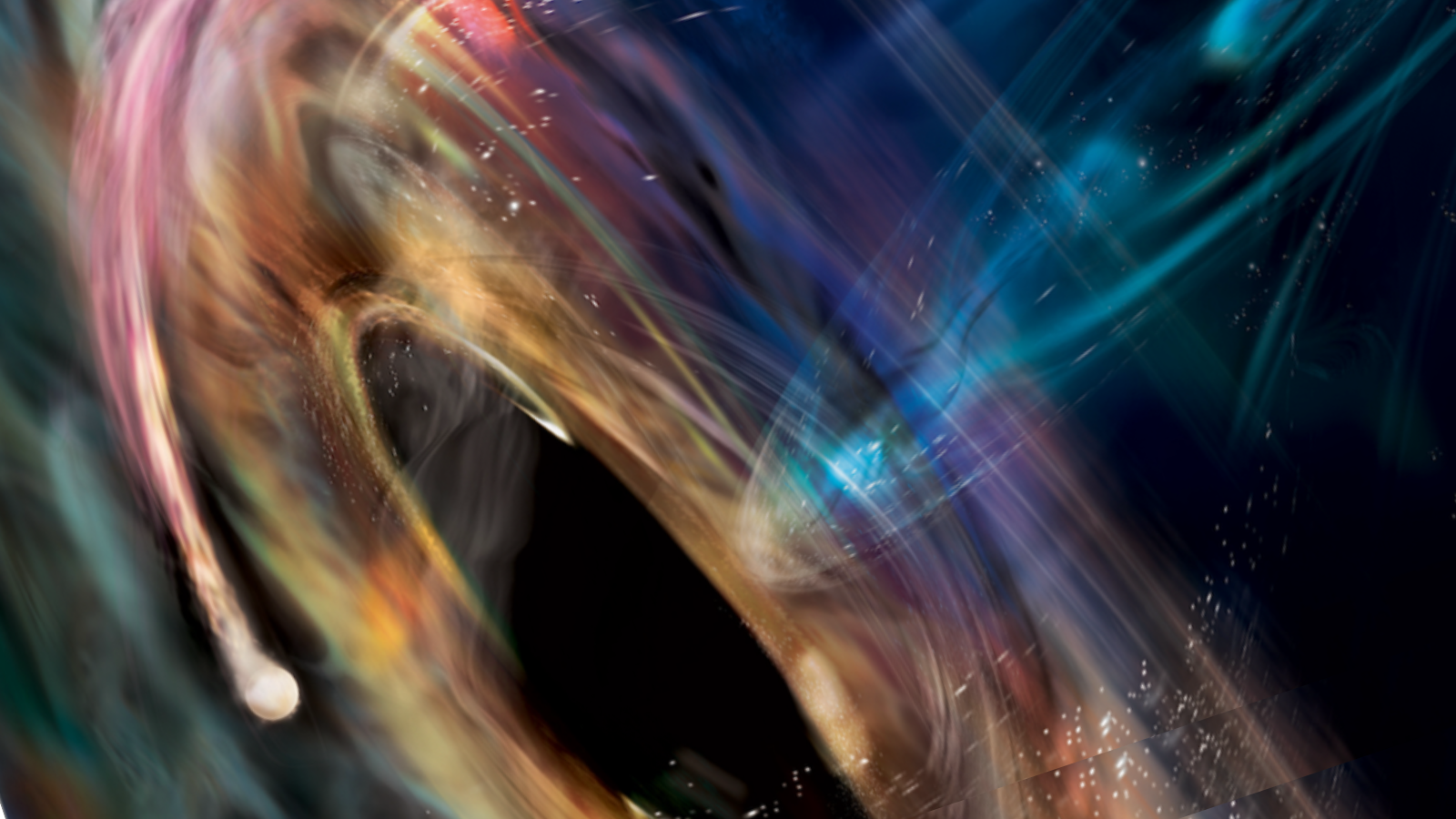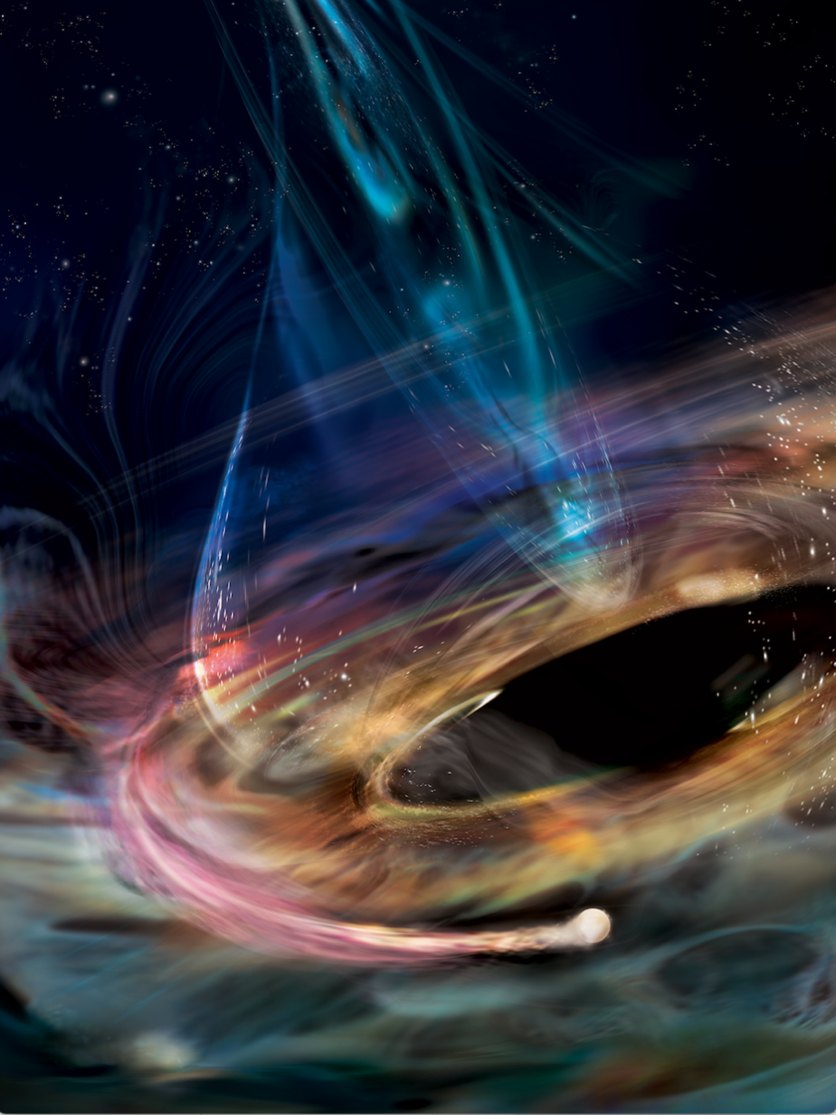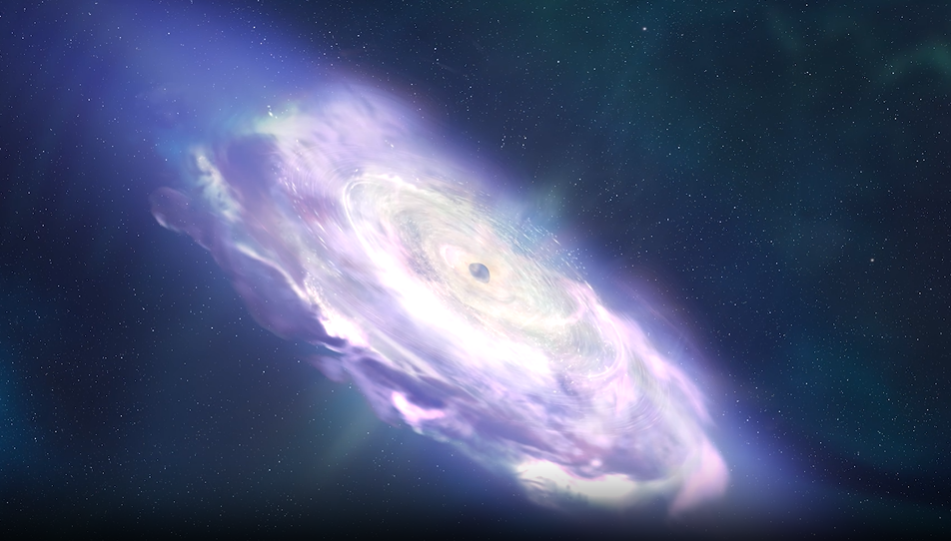
Using the XMM-Newton X-ray telescope, astronomers have witnessed a supermassive black hole already noted for its mysterious behavior demonstrating another strange phenomenon.
The Massachusetts Institute of Technology (MIT) team thinks that a dead stellar core, or white dwarf, daringly teetering on the edge of the black hole is the cause of increasingly frequent explosions of high-energy light.
The black hole in question is 1ES 1927+654, located around 270 million light-years from Earth, with a mass around 1 million times that of the sun. 1ES 1927+654 first announced its weirdness to astronomers in 2018 when the whirling cloud of plasma surrounding it, known as the corona, vanished and then reappeared. This was something astronomers had never seen happen around a black hole before.
Things got even stranger when the MIT team spotted bursts of X-rays erupting from 1ES 1927+654 with accelerating frequency. Over the course of two years, the rate of these high-energy flashes increased from once every 18 minutes to once every 7 minutes. This is also unprecedented behavior for a black hole.
If these weird episodes are the result of an orbiting white dwarf, a type of stellar remnant left behind when a star with around the mass of the sun dies, then this dead star is performing an incredible balancing act.
"This would be the closest thing that we know of around any black hole," team co-leader and MIT researcher Megan Masterson said in a statement. "This tells us that objects like white dwarfs may be able to live very close to an event horizon for a relatively extended period of time."

If the source of these strange episodes is a finely balanced white dwarf, the researchers theorize that it could be detected using ripples in space and time called gravitational waves emitted from the system.
Current gravitational wave detectors such as the Laser Interferometer Gravitational-Wave Observatory (LIGO) aren't sensitive enough to spot such an emission. However, upcoming gravitational wave observatories like NASA's space-based detector LISA (Laser Interferometer Space Antenna) may be precise enough to make such a detection.
"These new detectors are designed to detect oscillations on the scale of minutes, so this black hole system is in that sweet spot," team member and MIT professor of physics Erin Kara said.
The strange history of 1ES 1927+654
Both Kara and Masterson have a long history with 1ES 1927+654. Both were part of the team that watched seven years ago as the supermassive black hole's corona went dark. They also watched as it regenerated itself after its disappearance.
For a brief time, the newly grown corona of 1ES 1927+654 was the brightest X-ray source in the sky over Earth. The striking nature of 1ES 1927+654 led the team to continue to investigate it.
"It was still extremely bright, though it wasn’t doing anything new for a couple of years and was kind of gurgling along. But we felt we had to keep monitoring it because it was so beautiful," Kara explained. "Then we noticed something that has never really been seen before."

To study 1ES 1927+654 in greater detail, the researchers turned to data collected by the European Space Agency (ESA) X-ray spacecraft XMM-Newton.
This revealed the increasing pulse frequency of X-rays from this black hole, a phenomenon called "quasi-periodic oscillations" that has been seen around black holes before. What is unique for 1ES 1927+654 is the fact that this flickering seemed to increase steadily from every 18 minutes to every 7 minutes over the course of two years.
"We’ve never seen this dramatic variability in the rate at which it’s flashing," Masterson explained. "This looked absolutely nothing like a normal supermassive black hole."
The fact that the flashing of 1ES 1927+654 was seen in X-rays gave the MIT team a very important clue about the cause of this strange behavior.
Living on the edge
X-rays are most likely to be generated from a violent and turbulent sea of rapidly moving plasma in the immediate vicinity of black holes. This high-energy light is much less likely to be emitted from further away from black holes where cooler plasma moves more slowly.
"Seeing something in the X-rays is already telling you you're pretty close to the black hole," Kara said. "When you see variability on the timescale of minutes, that's close to the event horizon, and the first thing your mind goes to is circular motion and whether something could be orbiting around the black hole."
The team determined that whatever is causing these X-rays is located within just a few million miles of the outer boundary or "event horizon" of the supermassive black hole. The event horizon is the point around every black hole at which gravity becomes so strong not even light is fast enough to escape.
The MIT researchers have two major theories to explain the strange behavior of 1ES 1927+654, the first of which relates to the black hole's corona.
"One idea is that this corona is oscillating, maybe bobbing back and forth, and if it starts to shrink, those oscillations get faster as the scales get smaller," Masterson said. "But we're in the very early stages of understanding coronal oscillations."

A much better-understood explanation would involve a cosmic daredevil: a tightrope-walking white dwarf with a mass of about 10% of that of the sun's.
In this scenario, the white dwarf would be emitting gravitational waves as it swirls around 1ES 1927+654. This would cause the dead star to draw closer to the black hole, which would cause it to move faster, thus increasing the frequency of the X-ray emissions.
Though this white dwarf is virtually at the point of no return in terms of its proximity to the supermassive black hole, the MIT team doesn't think that this dead star will fall into the black hole anytime soon. That is because as the black hole drags the white dwarf inward, the dead star is shedding material. That is kicking it backward, keeping the white dwarf clear of the event horizon.
"Because white dwarfs are small and compact, they're very difficult to shred apart, so they can be very close to a black hole," Kara explained. "If this scenario is correct, this white dwarf is right at the turnaround point, and we may see it get further away."
The researchers intend to continue observing 1ES 1927+654 and will turn to increasingly more sophisticated telescopes to do so. They also intend to use LISA, set to launch in the 2030s to "hear" gravitational waves rippling away from the potential daring white dwarf defying certain death around this black hole.
"The one thing I've learned with this source is to never stop looking at it because it will probably teach us something new," Masterson concluded. "The next step is just to keep our eyes open."
The team presented their research at the 245th meeting of the American Astronomical Society in National Harbor, Maryland on Monday (Jan. 13). Their results will be published in the journal Nature.







